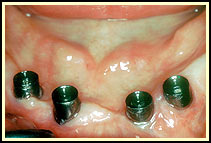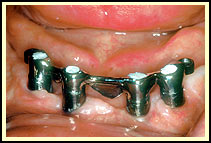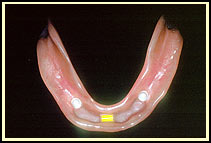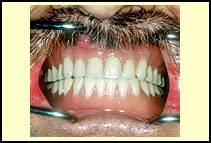November 23, 2016
What Is It?
An implant-supported denture is a type of overdenture that is supported by and attached to implants. A regular denture rests on the gums, and is not supported by implants.
An implant-supported denture is used when a person doesn't have any teeth in the jaw, but has enough bone in the jaw to support implants. An implant-supported denture has special attachments that snap onto attachments on the implants.
Implant-supported dentures usually are made for the lower jaw because regular dentures tend to be less stable there. Usually, a regular denture made to fit an upper jaw is quite stable on its own and doesn't need the extra support offered by implants. However, you can receive an implant-supported denture in either the upper or lower jaw.
You should remove an implant-supported denture daily to clean the denture and gum area. Just as with regular dentures, you should not sleep with the implant-supported dentures at night. Some people prefer to have fixed (permanent) crown and bridgework in their mouths that can't be removed. Your dentist will consider your particular needs and preferences when suggesting fixed or removable options.
How Does It Work?
There are two types of implant-supported dentures: bar-retained and ball-retained. In both cases, the denture will be made of an acrylic base that will look like gums. Porcelain or acrylic teeth that look like natural teeth are attached to the base. Both types of dentures need at least two implants for support.
- Bar-retained dentures — A thin metal bar that follows the curve of your jaw is attached to two to five implants that have been placed in your jawbone. Clips or other types of attachments are fitted to the bar, the denture or both. The denture fits over the bar and is securely clipped into place by the attachments.
- Ball-retained dentures (stud-attachment dentures) — Each implant in the jawbone holds a metal attachment that fits into another attachment on the denture. In most cases, the attachments on the implants are ball-shaped ("male" attachments), and they fit into sockets ("female" attachments) on the denture. In some cases, the denture holds the male attachments and the implants hold the female ones.
The Implant Process
The implants usually are placed in the jawbone at the front of your mouth because there tends to be more bone in the front of the jaw than in the back. This usually is true even if teeth have been missing for some time. Once you lose teeth, you begin to lose bone in the area. Also, the front jaw doesn't have many nerves or other structures that could interfere with the placement of implants.
The time frame to complete the implant depends on many factors. The shortest time frame is about five months in the lower jaw and seven months in the upper jaw. This includes surgeries and the placement of the denture. However, the process can last a year or more, especially if you need bone grafting or other preliminary procedures.
Two surgeries usually are needed. The first one places the implants in the jawbone under your gums. The second surgery exposes the tops of the implants. The second procedure comes three to six months after the first.
A one-stage procedure is now used sometimes. In this procedure, your dentist can place the implants and the supporting bar in one step. The success rate of this procedure is high.
Initial consultation
Before any work is done, you will visit either a dental specialist called a prosthodontist or a general dentist who has advanced training in the placement and restoration of implants.
During the exam, the dentist will review your medical and dental histories, take X-rays and create impressions of your teeth and gums so that models can be made. In some cases, the dentist may order a computed tomography (CT) scan of your mouth. This shows where your sinuses (located above your upper teeth) and nerves are. It allows the dentist to make sure they will not be affected by the implant placement. A CT scan also may be done to see how much bone is available and to determine the best locations for the implants.
If you are not already wearing a complete denture to replace your missing teeth, your dentist will make you one. You will use this temporary denture until the implant-supported denture is placed. It will take about four visits, spanning several weeks, to complete this denture. By making this temporary denture, your dentist is able to determine the best position for the teeth in the final denture. The temporary denture also can be used as a backup if something happens to the final implant-supported denture. The temporary denture can also be used as the final denture to reduce overall costs. Attachments will need to be added so it can fit securely to the implants.
Once the temporary denture is finished, the surgeon will use a copy of it as a guide to help place the implants in the proper positions. Holes will be drilled in the copy of the denture so that the surgeon can see where the implants should be placed.
First surgery
Month 1 (if no denture needs to be made)
Month 2 (if denture needs to be made)
The first surgery involves placing the implants in the jawbone. During the first surgery, an incision is made in the gum where the implant will be placed. A hole is drilled in the bone, the implant is placed into the hole, and the incision is stitched closed.
After this surgery, you should avoid putting pressure on the implants. The temporary denture can be made so that direct pressure is placed on other areas, not on the implants. It may also be given a soft reline (new lining next to your gums) to help to reduce the pressure on your gums.
After the first surgery, the dentist will wait three or four months if implants were placed in the lower jaw, and five or six months if they were placed in the upper jaw, before scheduling the second surgery. During this time, the bone and the implants integrate (attach and fuse).
Second surgery
Month 4 or 5 (no denture needed to be made)
Month 5 or 6 (denture needed to be made)
Once the implants have become fused with the bone, the second surgery can be scheduled. Your dentist will confirm whether the implant is ready for the second surgery by taking an X-ray. This surgery is simpler than the first. A small incision is made in your gum to expose the tops (heads) of the implants.
A healing cap (collar) is placed on the head of each implant after it is exposed. This guides the gum tissue to heal correctly. The collar is a round piece of metal that holds the gums away from the head of the implant. The collar will be in place for 10 to 14 days. The dentists will adjust your temporary denture again and it may be given another soft reline. The reline material will secure the denture to the healing abutments.
About two weeks after the second surgery, the healing caps will be replaced with regular abutments. Your gums should now be healed enough for your dentist to make an impression of your gum tissue and abutments. The impression is used to make a working model of your abutments and jaw. This model is used to make the denture framework and teeth.
Denture Try-In and Insertion
Month 5 or 6 (no denture needed to be made)
Month 6 or 7 (denture needed to be made)
At this point, the metal bar is placed on the abutments. You will have the first try-in of your new denture framework to see if it fits properly.
Once the metal bar and the denture framework have been fitted together properly, the teeth are temporarily placed on the framework in wax. The whole denture is then tried in your mouth. If everything works well, the teeth are secured in the denture framework permanently. The bar or ball attachments also will be secured.
You will have to return to your dentist for another visit to have the completed denture inserted. When the denture is inserted, the denture is clipped onto the bar or snapped onto the ball attachments.Once the metal bar and the denture framework have been fitted together properly, the teeth are temporarily placed on the framework in wax. The whole denture is then tried in your mouth. If everything works well, the teeth are secured in the denture framework permanently. The bar or ball attachments also will be secured.
At this point, your temporary denture will be given a new reline. This will allow it to be used as a backup denture in case you lose or break your new overdenture. If you are using the "temporary" denture as a permanent denture, the bar or ball attachments are placed in that denture.
Caring for Your Implant-Supported Denture
You will need to remove the denture at at night and for cleaning. You also should carefully clean around the attachments.
Your dentist will test all the parts of your new denture to see if they are secure. Even though your denture is stable, it still can move slightly when you chew. This slight movement can cause the denture to rub against your gums, which can cause sore spots. Your dentist will check your gums and also will check the way your top and bottom teeth come together (your bite) after insertion of the denture.You will need to remove the denture at at night and for cleaning. You also should carefully clean around the attachments.
The clip or other attachments on the bar-retained denture usually will need to be replaced every 6 to 12 months. They are made of a plastic material (nylon) and will wear after continued use.
What Will X-Rays Show?
An X-ray will show the implants in the jaw and any attachments to them. Your dentist in Hollywood, FL will take X-rays a few times during the procedure. They help the dentist to see that the implants, abutments and attachments are in the right places.
Possible Complications
In addition to the risks of surgery and of the implants failing, a bar-retained denture carries certain risks of its own.
A bar-retained denture needs space on the denture framework for the special attachments that are fitted to the bar. This means that there is less space available on the denture framework for the teeth to be fitted. Because of this, the teeth sometimes can come loose from the base. This problem is easily fixed.
Also, when the bar is attached to the implants it is important that the bar is evenly balanced on each implant. Dentists call this a "passive fit." If the fit is not passive, the extra strain on the bar can cause the screws to loosen. If you grind or clench your teeth, it's more likely that parts of the denture will break or that your implants will come loose.
What Can You Expect From Your Implant-Supported Denture?
Your implant-supported denture will be more stable than a regular denture. You will find it easier to speak and you won't have to worry about the denture becoming loose or falling out of your mouth. You generally will be able to eat foods you could not eat before. However, you will not be able to chew hard or sticky foods because they can damage the denture.
If you have an implant-supported denture in your upper jaw, it can be made to cover less of your palate (roof of your mouth) than a regular denture. That's because the implants are holding it in place instead of the suction created between the full denture and your palate.
Aetna, Inc.
Testimonials
Dr. Gorbatov was very thorough and went over all concerns I had (I'm not really a fan of the dentist). He is definitely the nicest Dentist I have ever been...
Sofia Rodriguez (Hallandale Beach, FL)
My experience, couldn’t ask for any better, great office, wonderful people. Professional in his field, with pleasant energy in his office Dr. Gorbatov, his assistant, Lidi, without whom all the...
Kirill Krassikov
Me atendieron de urgencia, excelente atencion y servicio. Lidi y carolina, muy simpaticas y una atencion de lujo!
Jonatan G. Samoluk
I have lived and worked all over North America. One of the greatest challenges of relocating is finding the best dental practice. "Center For Dental Excellence" was recommended to me...
Gregory Sutton (Wellington, FL)
I have been going to Dr Gorbatov at A Center For Dental Excellence for many years now and their use of "Excellence" isn't just a marketing ploy and they definitely...
Lawrence F. (Lake Worth, FL)
This is the best dentist in the world who really cares about each and every patient and makes your smile look perfect! After visiting the new office you will be...
Kseniia Dursinova (Sunny Isles, FL)
FIVE STARS! I left my pre you’d Hollywood dentist because she refused to do a simple noninvasive ADA recommended preventive treatment, and insisted I needed an implant. In addition her...
therese costa
Always highly satisfied with Dr.Gorbatov and his lovely staff. Very professional and kind , Happy Holidays !!
Haleigh Podrazik
Great Dentist and Team. Fantastic experience and service. My husband had a dental emergency while on vacation and Anna got us in immediately. Dr. Gorbatov is very attentative and caring...




